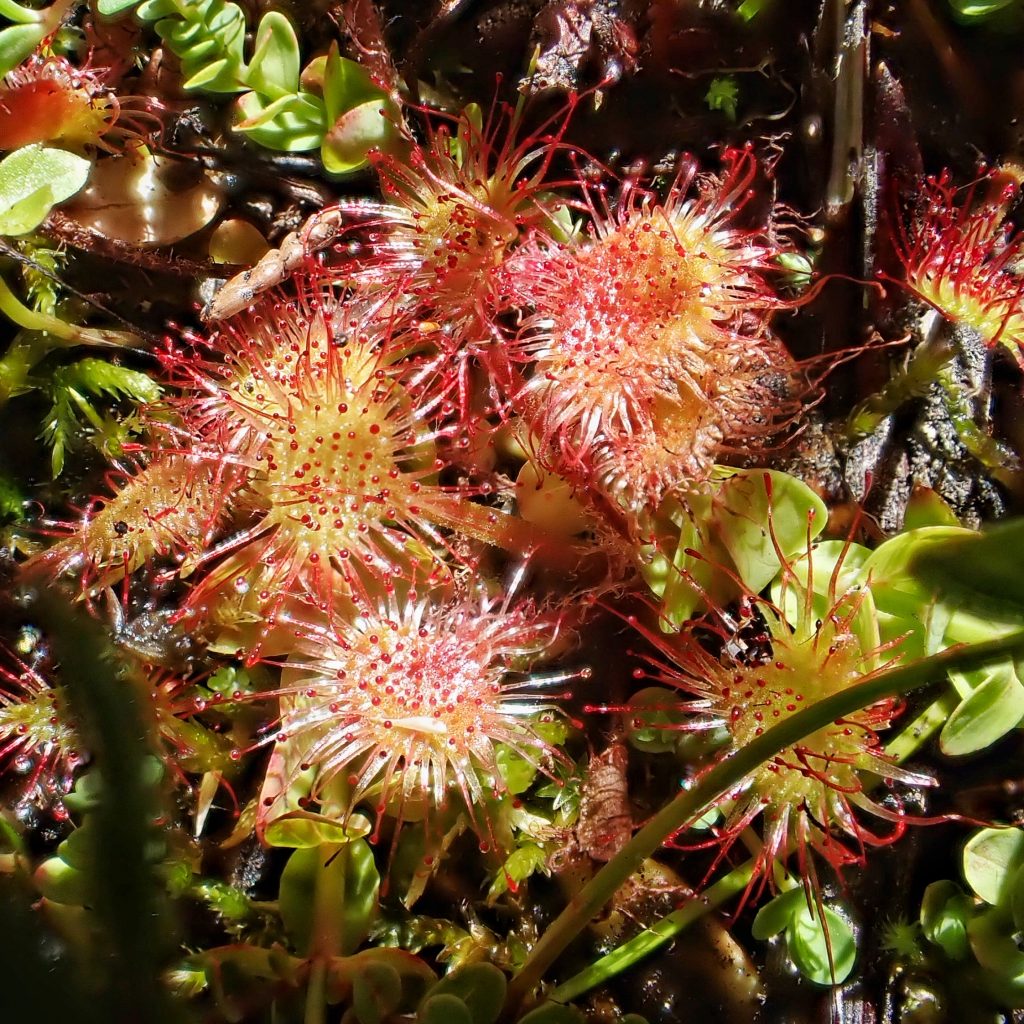
I’ve recently profiled moths with predaceous caterpillars (Cosmia calami (American Dun-bar Moth), and moths whose larvae are parasitoids of wasp larvae (Chalcoela iphitalis (Sooty-winged Chalcoela), but the ultimate example of reversing what seems like the natural order of the relationship between eating and eaten has to belong to carnivorous plants, like these Drosera rotundifolia (roundleaf sundew). As with most carnivorous plants, this adaptation was selected for to counter the effects of the low nutrient, nitrogen poor environments in which they live, or, possibly more accurately, allowed them to survive in areas as they became more nutrient poor, or to expand their territory into areas that had poorer soil.
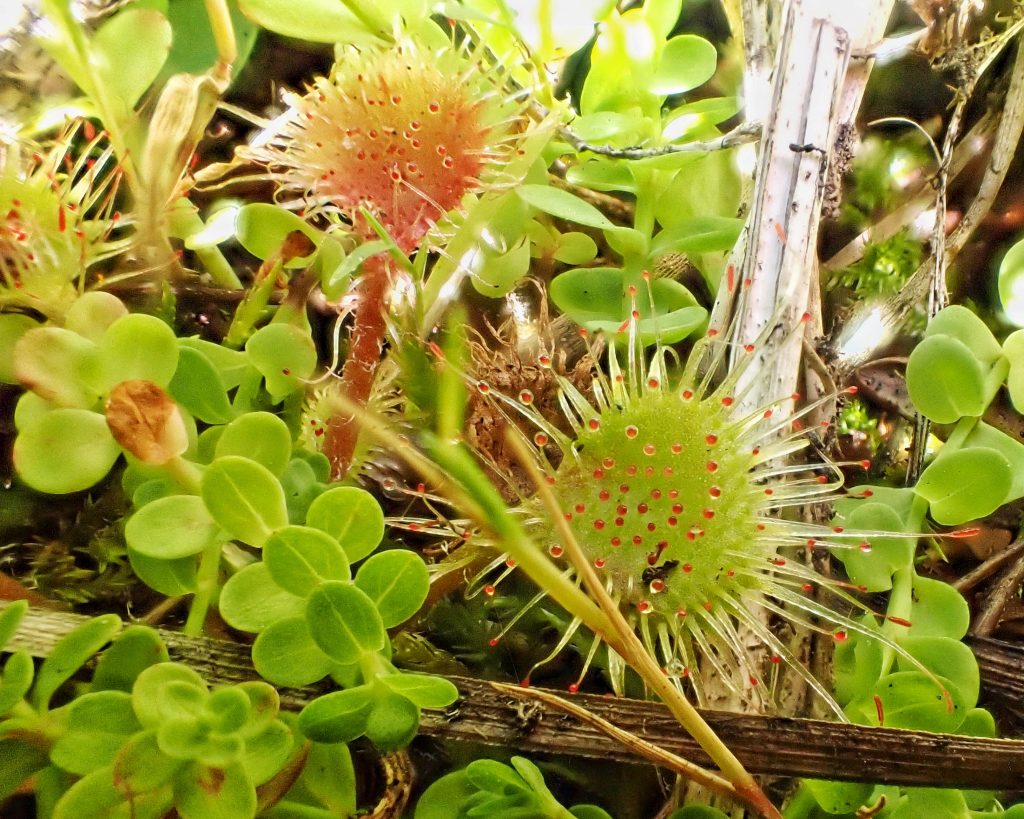
“Roundleaf sundew compensates for the low available nutrients in its habitat by catching and digesting insects [8,45,49,54]. Insects are caught with the sticky glandular leaf hairs, and the leaf then folds around the prey. The hairs secrete proteolytic enzymes which digest the insect and enable the plant to absorb nutrients through its leaves [37,45,52]. Insect capture is generally believed to enhance growth and reproduction of roundleaf sundew [8,24,29,46,56]. It is significantly correlated (p<0.01) with total leaf number, number of new leaves formed, and total leaf area [46]. However, Stewart [50] determined that roundleaf sundew did not benefit from insect capture in field experiments in the Jefferson National Forest, Virginia. The benefits of insectivory may be site-dependent; roundleaf sundew may benefit most from insect capture on the most nutrient-poor sites.” Drosera rotundifolia
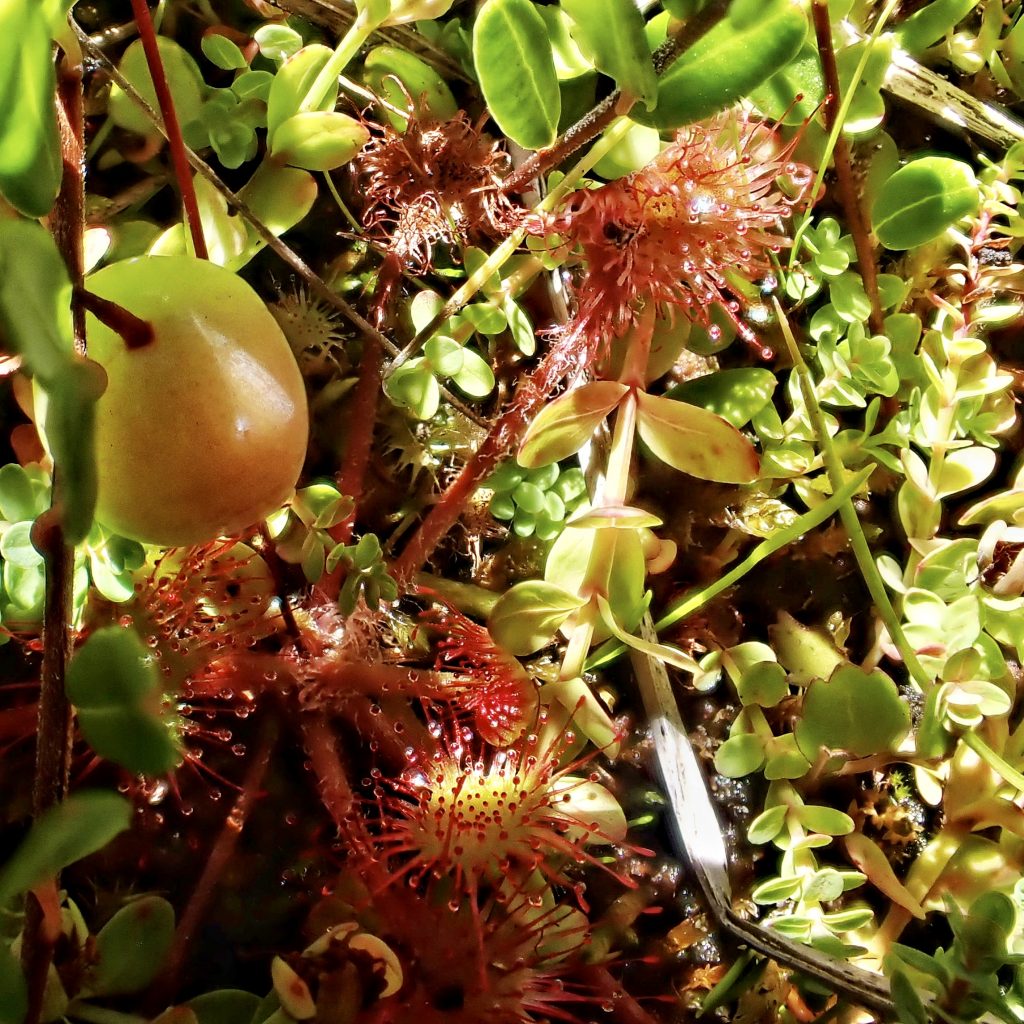
Roundleaf sundew is indiscriminate in the insects it catches, and its prey is mostly determined by what is not strong enough to escape the grasp of its sticky secretions. However, according to M. Thum (1986), in comparison to other Drosera they tend to capture more springtails than flying insects. But, because it was in a paper where I could only access the abstract and so can’t provide more details, I can’t say whether that is because the leaves of D. rotundifolia are more horizontally oriented than those of other Drosera, or whether it is because roundleaf sundew tends to occupy slightly higher and drier (a very relative term in a bog or fen) ground than the other species. It is also interesting to note that “Roundleaf sundew may be an important food source for bog-dwelling ants. Ants are opportunistic predators of insects trapped in the leaves of roundleaf sundew, scavenging up to two-thirds of the prey caught by the plant [57].” Drosera rotundifolia
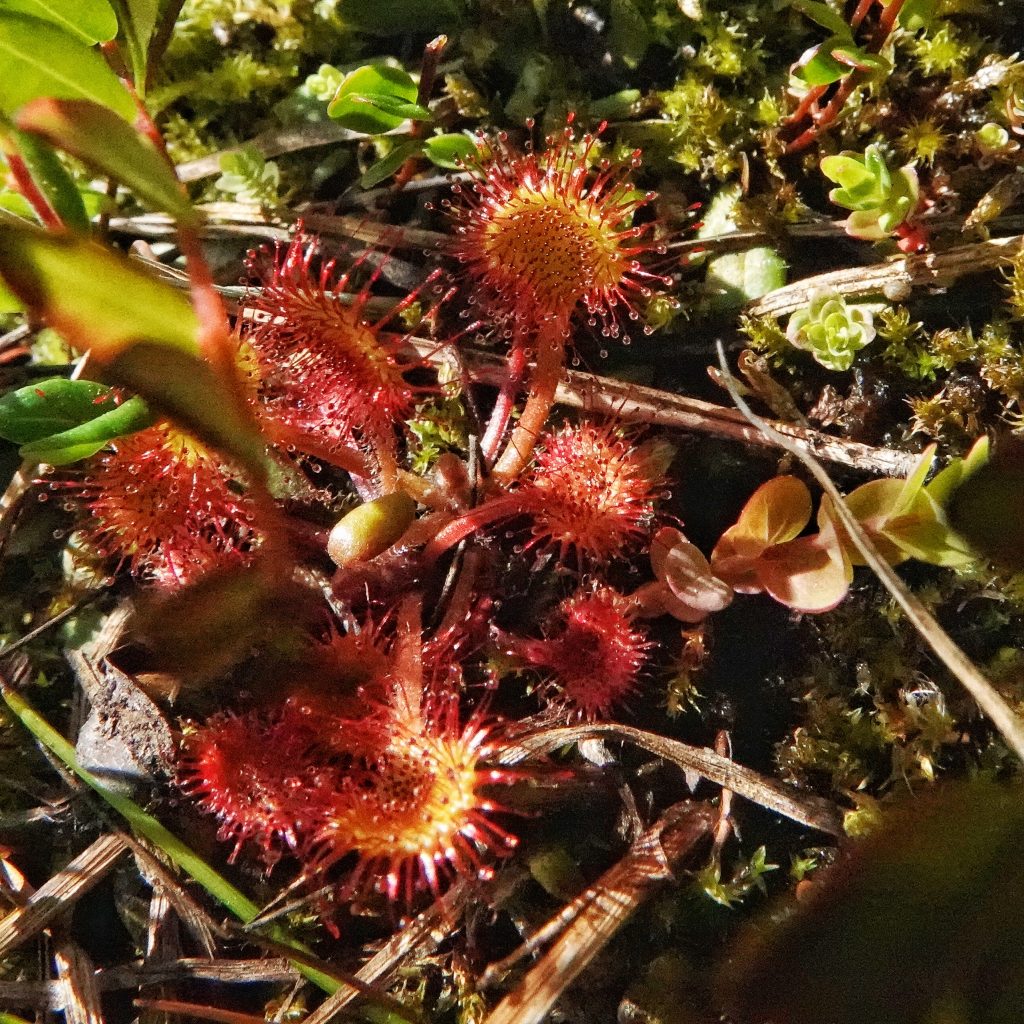
I apologize for having no photos of the tiny flowers of this plant, or of its sympatric cousin Drosera anglica, but though it is said to flower from June into September in our region, and I made three trips from late June to mid August to the bog in South Prairie, I did not find it blooming. If and when I do encounter the flowers of this species (which are said to be pollinated by wind and some of the same small insects that are trapped by its hairs, as well as being capable of self fertilization), I will post them here. But I felt comfortable doing this profile without them, because sundews are one of the small number of plants that are more identifiable by their leaves than by their flowers.
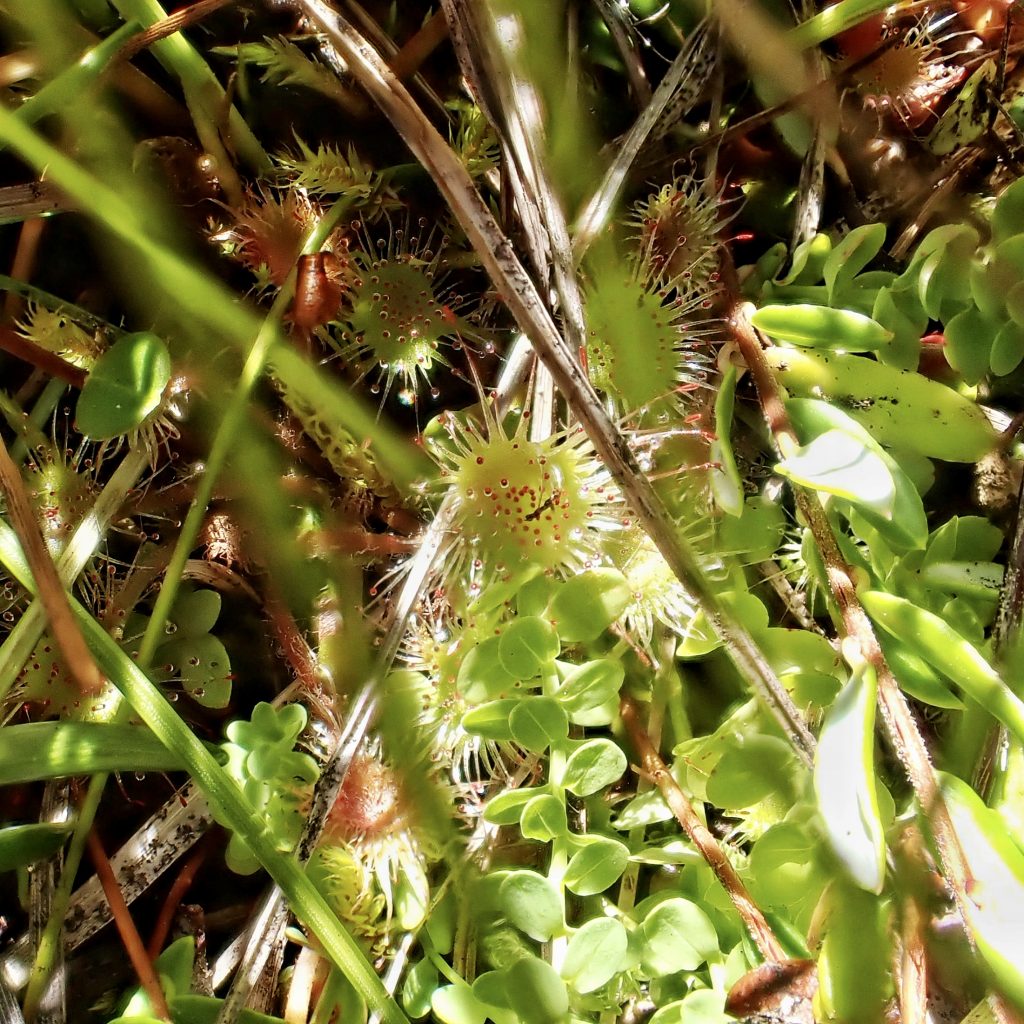
Ethnobotany– “Plant used for corns, warts and bunions…Plant used as a ‘medicine to make women love-crazy,’ a love charm.” BRIT – Native American Ethnobotany Database “Roundleaf Sundew appears to have limited edible or medicinal use in the US. Native American groups reportedly made little use of this plant. Historical accounts suggest that Roundleaf Sundew has been used in the past in Europe as a herbal remedy for a variety of ailments, including warts, chronic bronchitis, asthma, and whooping cough. For instance, a tincture of the plant was said to be used for dry, spasmodic coughs; a poultice of plant juice was reportedly used on corns and warts. Harvesting of the plant for use in European herbal medicine has raised conservation concerns.” Roundleaf Sundew | Drosera rotundifolia; “Leaves of roundleaf sundew can curdle milk and were used in Sweden to make cheese. Fresh leaves have also been used to treat warts. Roundleaf sundew has been used as a remedy for respiratory ailments. The plant contains an antibiotic effective against Streptococcus, Staphylococcus, and Pneumococcus bacteria [43].” Drosera rotundifolia
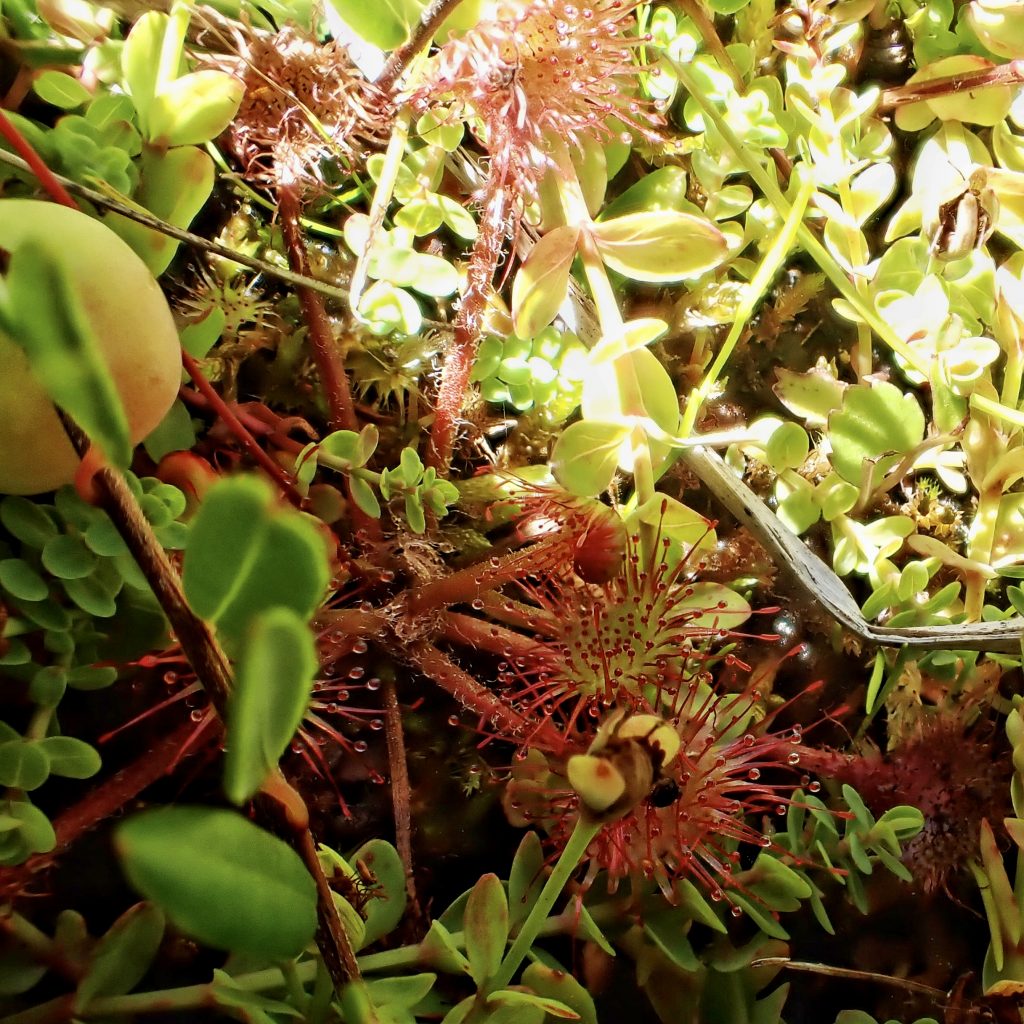
Description– “Leaves spreading out from rosette, as wide as they are long, with long petioles. Leaf upper surface covered with hairs holding small glands that secrete a sticky fluid to trap insects. Leaf folds around prey to digest it with enzymes and bacteria. Flower stems hold 1 to several flowers each (not pictured). Flowers in parts of 5. Calyx fused at base, petals white or pink. Seedpods long, narrow, light brown.” Drosera rotundifolia | Roundleaf Sundew | Wildflowers of the Pacific Northwest; “The leaves are small and round (about ¾ inch across). The upper surfaces are covered with reddish, glandular hairs, each tipped with a clear, sticky secretion that glistens in the sun. The green or red leaf stalks are flat, ½ to 2 inches long, and covered with fine hairs. The leaves generally lie flat or nearly flat against the ground.” Roundleaf Sundew | Drosera rotundifolia
Similar species– Drosera anglica has oblong to spatulate leaves, which tend to be vertical rather than horizontal.
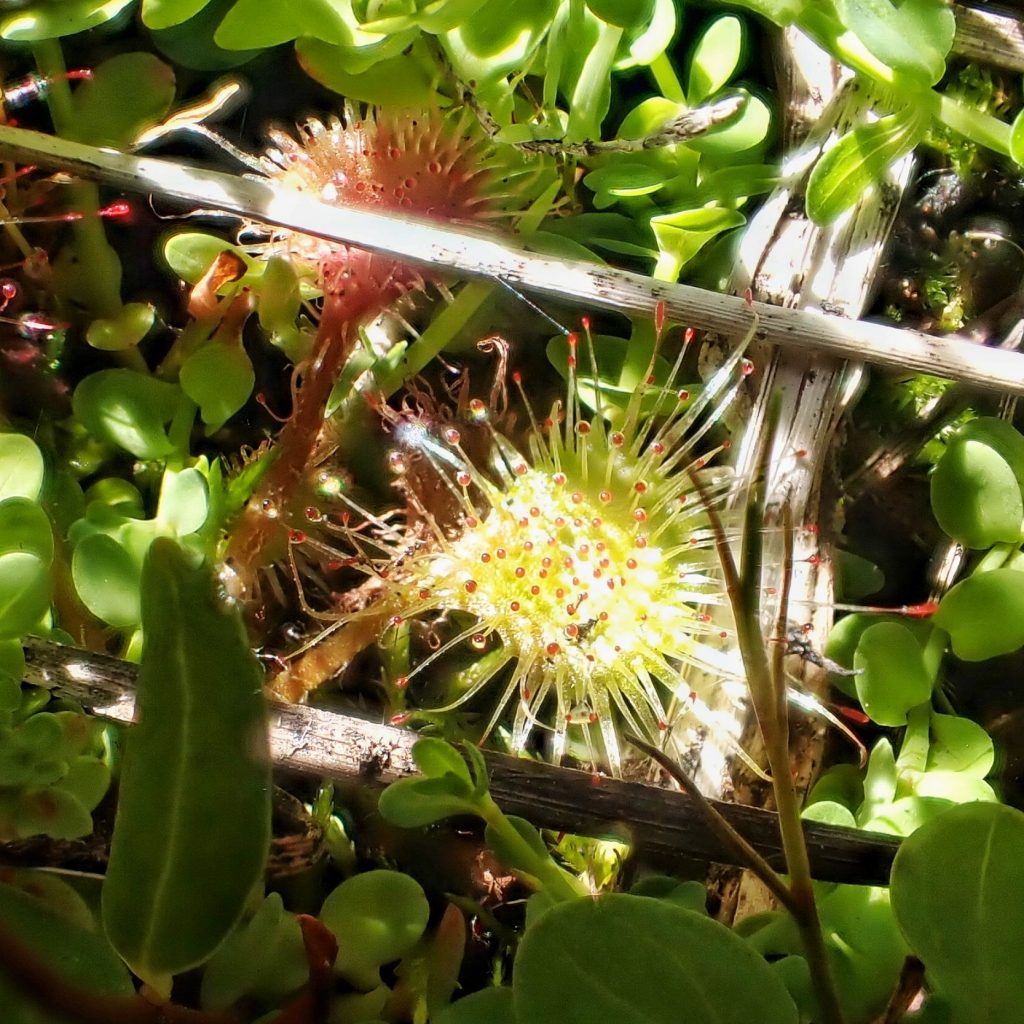
Habitat– “Roundleaf Sundew is classified as an obligate wetland (OBL) species, meaning that it is generally restricted to sites that provide continually moist or wet situations. Roundleaf Sundew is most often found in acidic bogs, but can also be seen growing in swamps or on rotting logs, mossy crevices, and floating sphagnum mats or hummocks. This species is also found on pond, lake, and stream margins. Roundleaf Sundew prefers full sun, but can survive in limited shade.” Roundleaf Sundew | Drosera rotundifolia
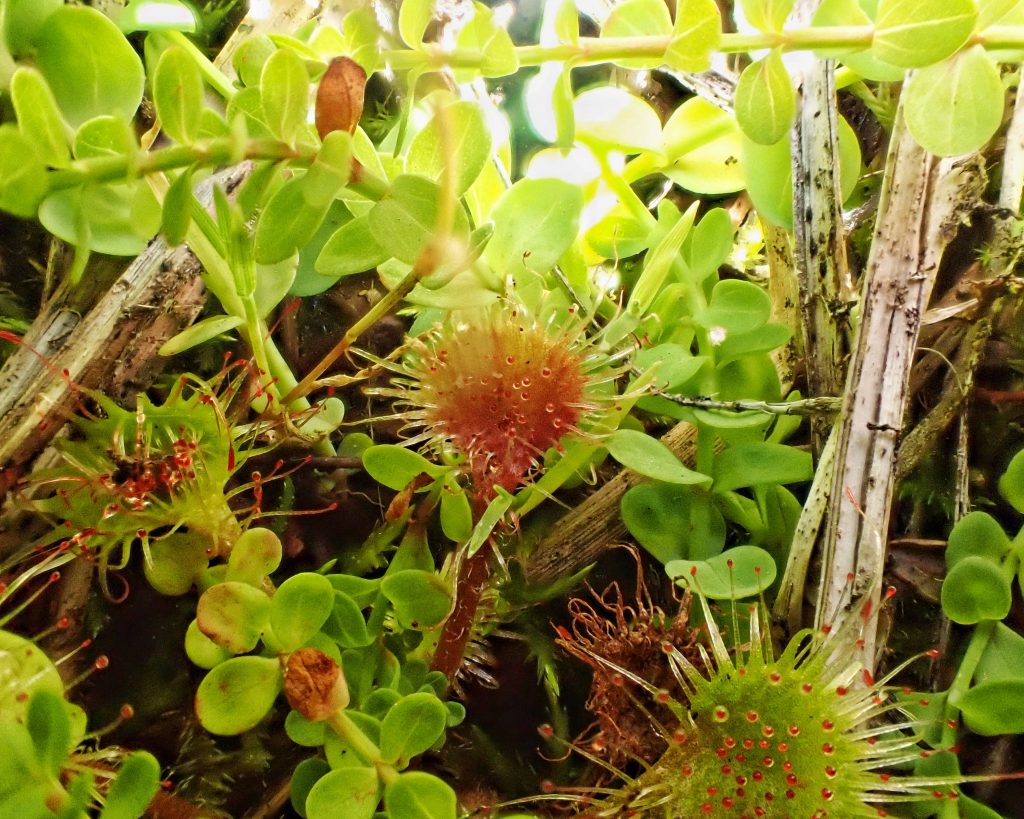
Range– “Roundleaf sundew is distributed from Greenland and Newfoundland west to Alaska. It occurs south along the Pacific coast to California and inland as far as western Montana and western Colorado. In the East, roundleaf sundew is found from Nova Scotia south to Georgia, Florida, and Alabama and west to the Mississippi River, Iowa, and Minnesota [14,19,21,44,45]. Roundleaf sundew is known from at least two locations in west-central Montana [32]. In Colorado, it is known from one bog in Gunnison County, a site that has been given special protection [60]. There is also one record of roundleaf sundew from a bog in Bottineau County, North Dakota [64]. Populations of roundleaf sundew also occur in Europe and Asia [21,22,44]. Drosera rotundifolia; in the PNW it is found primarily along the coast, in the Coast Range, the Cascades, and the Rockies and their associated ranges
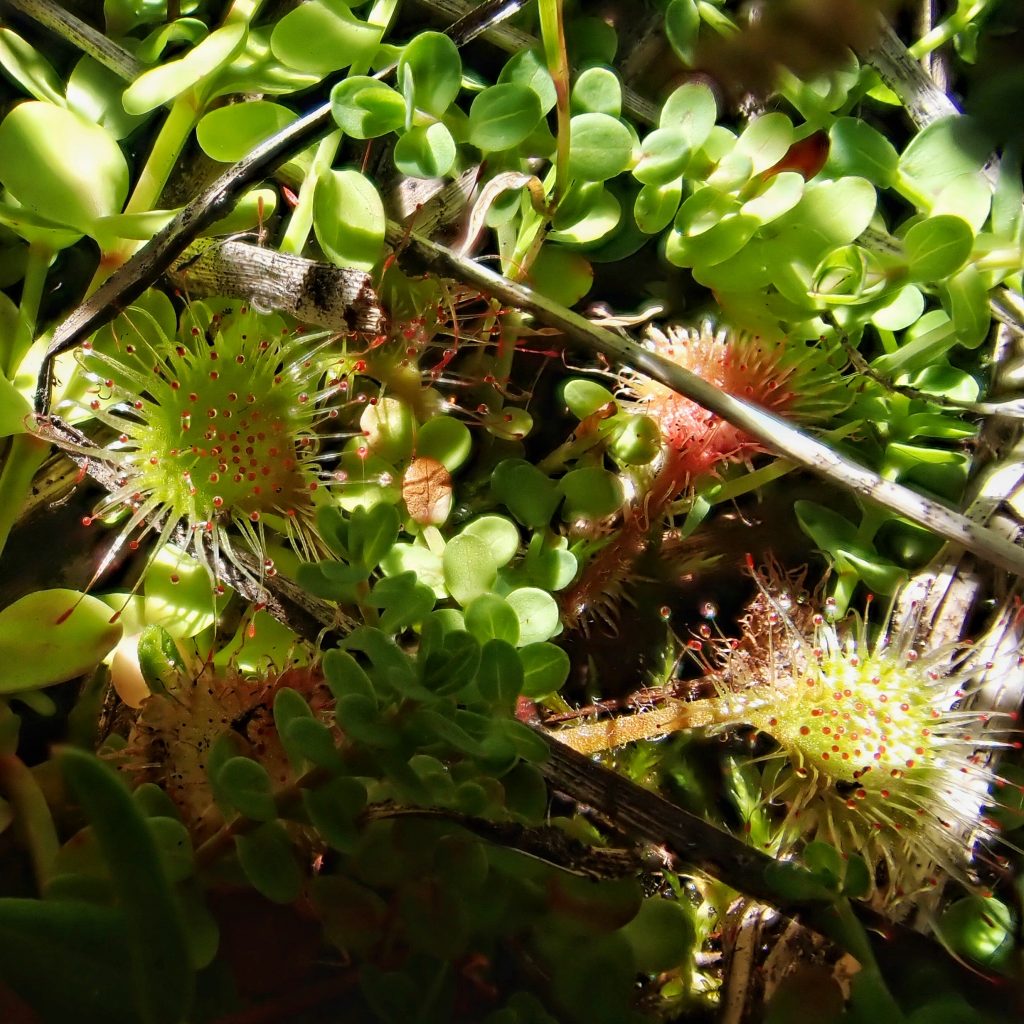
Eaten by– “Roundleaf sundew is commonly eaten by moose on the Kenai Peninsula of Alaska in late May and June when in preflowering and early flowering stages [34].” Drosera rotundifolia; not surprisingly for a plant that traps insects for a living, I can find no arthropods in our region that feed on this plant, although in the se US the larvae of Buckleria parvulus are known to feed on this.
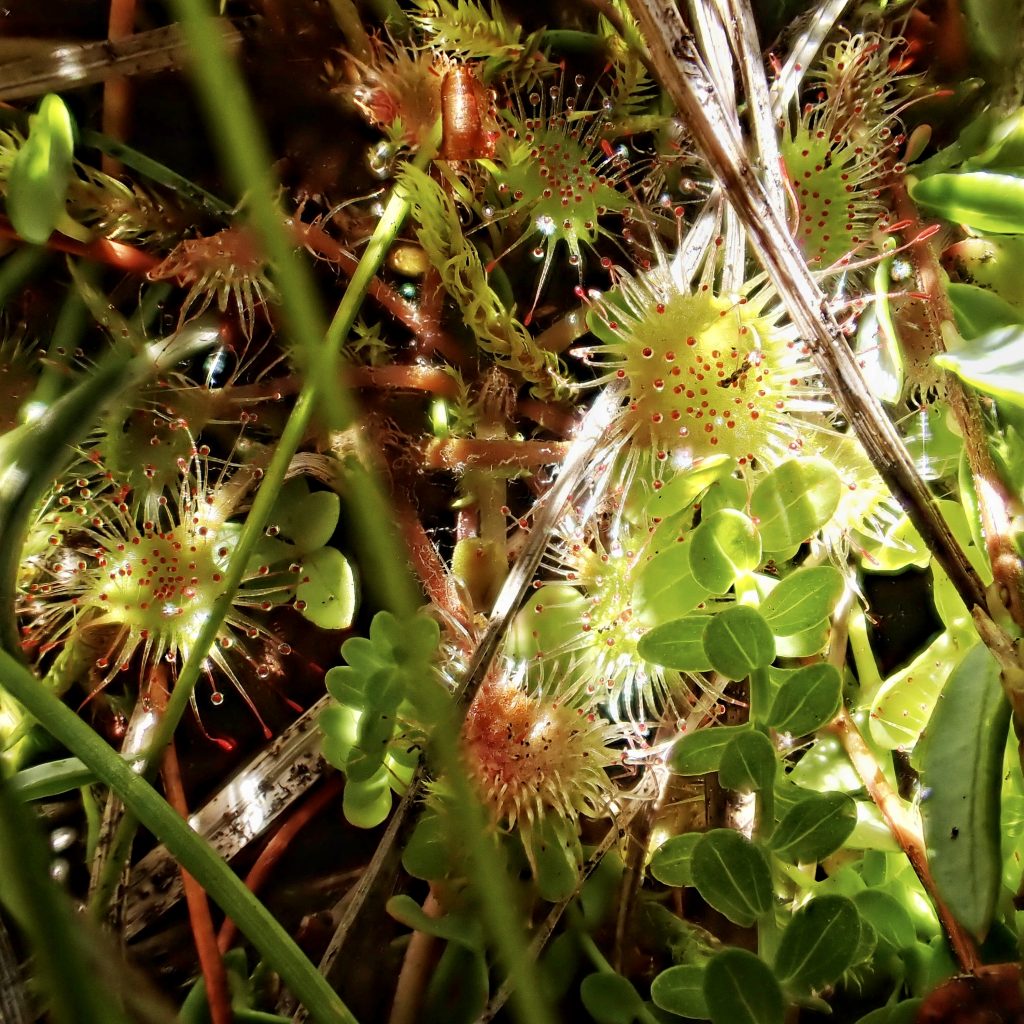
Reproductive timing– Said to flower from June into September in our region.
Etymology of names– Drosera is from the Greek word for ‘dewy’, an allusion to the secretions that glisten on the hairs. The specific epithet rotundifolia is from the Latin words for ‘round leaf’, and refers to the shape of the leaves.
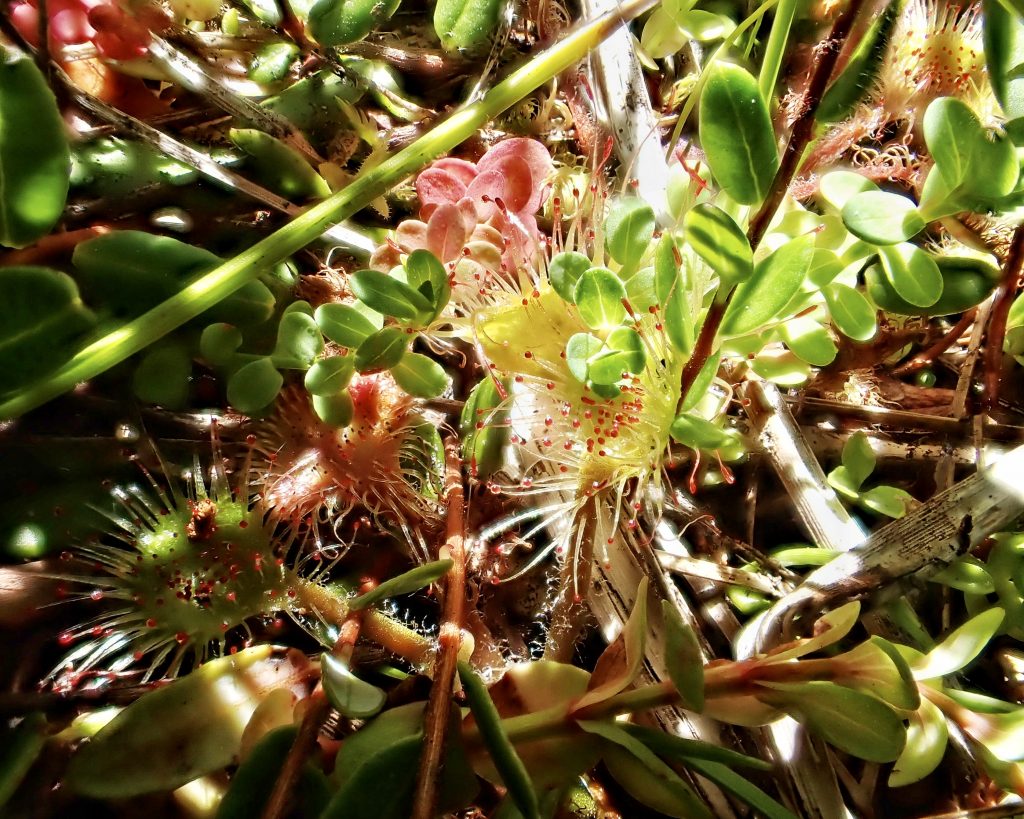
OregonFlora Drosera rotundifolia
Drosera rotundifolia – Burke Herbarium Image Collection
Roundleaf Sundew | Drosera rotundifolia
BRIT – Native American Ethnobotany Database
Drosera rotundifolia | Roundleaf Sundew | Wildflowers of the Pacific Northwest
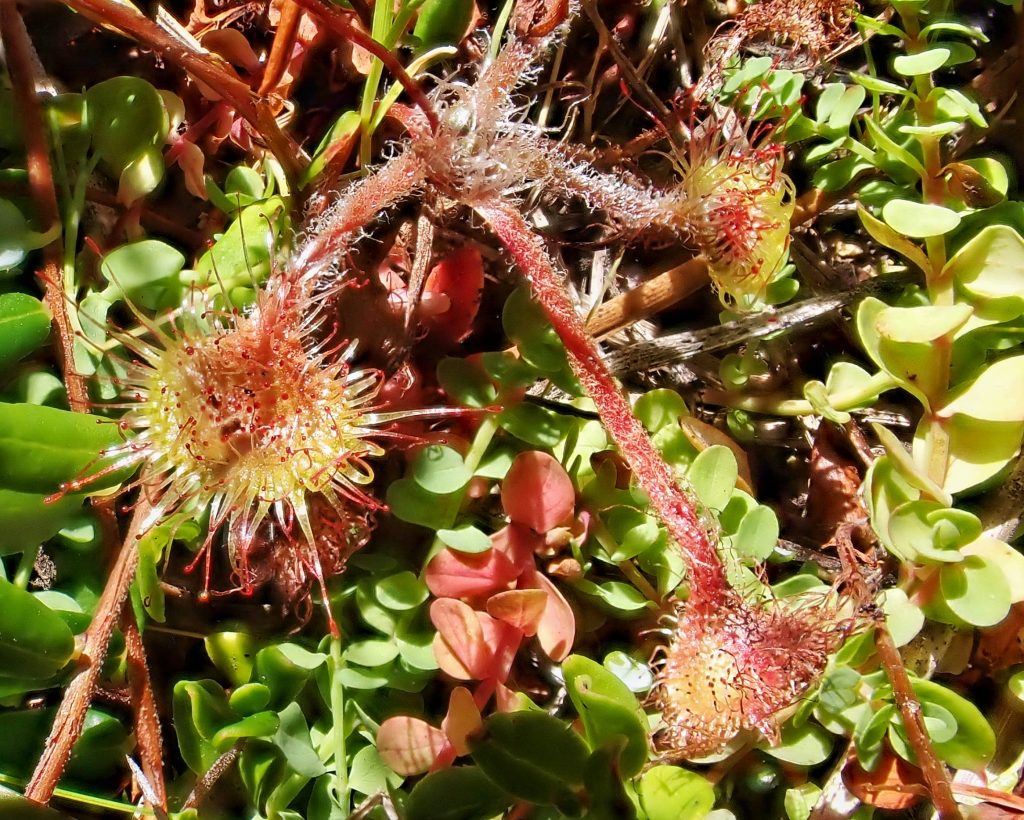
I have seen it blooming in early summer.
Thanks, David! I’ll be watching for it next year.
I don’t think I’ve thanked you for your work before this. So thanks a bunch Dan! I enjoy your profiles of critters I don’t know about (many bugs) or have not thought to care much about (little moths…). But most of all, I appreciate the new details you provide about old friends – mostly plants. This one is no exception. _Buckleria parvulus_? Seriously? “…They first ingest the sticky fluid at the tips and then clear away a patch of these hairs before feeding on the rest of the leaf. They will also eat dead insects trapped by the leaves.” Scavenger moths!
Anyway thanks for being you. You make my life better
Thank you so much for your appreciation, Wes! I’m glad to hear you enjoy reading these, seemingly as much as I enjoy writing them!